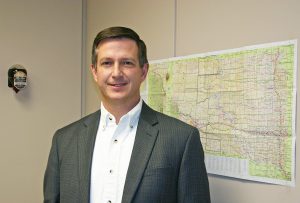The unifying challenge across South Dakota for economic development is finding the right people with the right skills to fill the right jobs.

Joe Fiala. Photo by Heidi Marttila-Losure
“Pretty much every time we visit a business owner, they let us know that it is a challenge to find the right people to fill their open positions,” said Joe Fiala, research and community development director with the Governor’s Office of Economic Development. We’re not alone in that—it’s (happening) across the country.”
Workforce challenges are compounded by the state’s 2.9 percent unemployment rate (as of September) compared to 4.9 percent nationally.
“Just matching up skill sets with job openings, I think, is the biggest challenge, whether its welding or data entry,” Fiala said. “It’s just across the board.”
Solutions are multi-pronged and aided by retaining a stable population of residents who are well-trained for local jobs that pay competitively in communities with suitable housing.
One solution is connecting with high school-age and younger students and with former residents looking to raise families back home.
“If you make those good, positive connections … you let them know they can have a career in a rural setting, and do really good work and do impactful work, I think that is important to address that workforce issue,” he said.
By connecting early, students —and the community—can consider the right training and experience to fill local, rural needs and foster changes coming in the state’s industries.
“We’re an ag state,” Fiala said. “(That is) one of our big strengths as a state. There continues to be growth in … the value-added agriculture segment of the economy.”
Other key industries are bioscience and biotech research and development; financial services; the hunting and outdoor industry; an energy sector that includes wind, oil and gas; and professional services such as engineering and software development.
South Dakota’s economic stability—described by Fiala as not having “real high highs” or “real low lows”—aids business owners in planning for a future that uses technology and a workforce trained for it.
Technology also allows for more efficiency.
“If you’re a small manufacturer in a small town, if you can become more efficient … and do work faster with fewer people, that’s not necessarily a bad thing in a small town,” Fiala said.
He emphasizes that rural communities should work together to lead the development process.
“In general I have a positive outlook for our rural communities. It’s going to take work,” Fiala said, but “there’s some great things that can happen across rural South Dakota with a little effort and focus.”
 Dakotafire Get your spark here.
Dakotafire Get your spark here.


